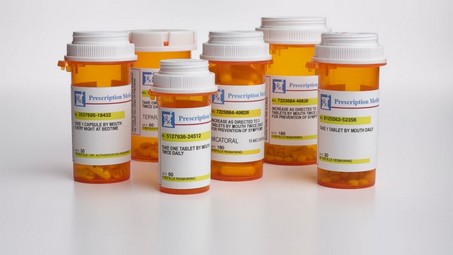Kentucky doctors are changing the way they prescribe pain medication
Ricki Barker, RichmondRegister.com
Writing the script for addiction?
Last month, Madison County EMS responded to nine drug overdose calls in a span of just 12 hours. Five of those came within nine minutes, said Carlos Coyle, director of Madison County EMS.
“The thing about this is, you don’t know how many used last night, went home, laid down and died,” Madison County Coroner Jimmy Cornelison said of the incident in a later interview with The Register.
As one of the front lines in the battle against the drug epidemic, Cornelison noted the strain addiction puts on medical professionals and emergency systems.
Unfortunately, those spikes in overdoses are becoming more common, as Kentucky is one of five states with the highest rates of death linked to drug overdose, according to the Centers for Disease Control and Prevention.
Everyone knows the drug epidemic is here, but where did it begin, and — most importantly — when will it end?
Some health officials say the work has already begun to turn back the tide of addiction, but the stakes are steep and the wait may be long.
The starting point
Dr. Jordan Prendergast, a primary care physician at Lexington Clinic, said if anyone wants to find the cause of the recent drug epidemic, they should look no further than their doctor’s office.
“I think it’s a true aspect (the epidemic began in medical offices). Research indicates that a lot of addiction begins when people are recovering from a recent surgery or medical procedure,” she said. “They are usually prescribed narcotics and become addicted to them. That is where the trouble begins.”
To understand addiction, it is important to understand people and the drugs themselves, the doctor said. Prendergast said people usually have a genetic predisposition to developing addiction problems.
“It’s a chemical imbalance,” she said. “When the narcotics are taken away, they try to fill that craving. Heroin is a cheaper alternative on the streets to pain pills and that is why we are seeing more heroin users. Heroin is easier to obtain than a prescription.”
Prendergast said, in recent years, physicians have begun to change the way they approach pain management in their practice.
Legislation and guidelines from the CDC have also tightened the belt on prescribers who are too lenient with opioid prescriptions.
“(The drug epidemic) has changed how I practice medicine,” Prendergast said. “I now spend more time educating my patients about the danger of narcotics and really diving into their medical histories.”
Prendergast said she, like others, are finding alternative ways to treat pain.
Some of the options doctors are now relying on is the practice of prescribing over-the-counter pain medication first and then reviewing the patient’s pain levels over the course of few days to see if a larger dose or more powerful medicine is needed.
In the past, doctors may have prescribed a patient a week’s worth of strong pain medication. Now, many have reduced that amount to only one or two days. Others only employ opioids on the day of surgery or an operation.
“It’s no longer the first line of defense we use for pain management,” Prendergast said. “We are starting off slow and then making sure we don’t overprescribe.”
But that wasn’t always the case, Prendergast said, and there is still a lot of work to do.

Pain pills are way of life to most Americans
The United States makes up about five percent of the world population, but uses nearly 80 percent of the world’s supply of prescription pain killers, according to the American Society of International Pain Physicians, which analyzed International Narcotics Control Board data.
Prendergast said the reliance on prescription pain medication can be traced back to the early 1990s, when many doctors were facing harsh criticism from specialists for “under treating” pain.
They argued that chronic pain such as backaches and joint pain could be alleviated more deftly with the use of opioids.
Predergast said physicians were caught in a conundrum.
Doctors take the Hippocratic Oath and pledge to “do no harm.” The oath also states there is an art to medicine and “that warmth, sympathy, and understanding may outweigh the surgeon’s knife or the chemist’s drug.”
It is those words that doctors were remembering when they were under fire for allegedly allowing people to “suffer” when a simple pill could provide relief.
“Years ago, physicians were encouraged to treat pain very aggressively,” Prendergast explained. “Now, we are treating pain more responsibly, but in the 90s, pain was often considered the sixth vital sign.”
The doctor noted that along with heart rate, temperature, blood pressure, respiration rates and pulse rates — pain level was another significant factor.
“Pain was treated to a certain level and doctors were trying to manage their patient’s pain very differently than we do today,” Prendergast said.
Long-acting opioids became a common go-to for physicians, who thanks to multi million dollar campaigns by pharmaceutical companies, thought the drugs they were prescribing were “less addictive” than traditional opioids.
Purdue Pharma, the maker of the drug OxyContin, was a big proponent of the message that their new drug was a “safer alternative” to traditional prescription pain killers in 1995.
Years later, in 2007, the pharmaceutical company agreed to pay $600 million to settle criminal charges that it lied to the public and physicians about how truly addictive its product was.
During that time, Prendergast said prescribers were very lenient with the prescription pad, creating addicts without even knowing.
In 2014, U.S. doctors wrote nearly 200 million prescriptions for opioid painkillers, while deaths linked to he drugs climbed to roughly 19,000 — the highest on record
Despite the death toll mounting, doctors continued to prescribe, many breaking the law to do so.
Soon, Kentucky became one of the worst states known for lenient prescriptions.
Prendergast said patients addicted to painkillers would go to numerous clinics to obtain prescriptions to feed their habit, a term called “doctor shopping,” looking for doctors with generous natures.
From 2011 through 2015, 12 out of every 1,000 doctors were disciplined for overprescribing narcotics in Kentucky. At least 20 of the state’s physicians were charged as drug dealers in federal court.
In 2011, shortly before the passage of House Bill 1, which laid out strict guidelines for prescribers of pain killers, Dr. Gary A. Shearer of Florence was considered one of the worst over prescribers of opioids in the state.
According to media reports at the time, Shearer continued to prescribe painkillers, even as 14 of his patients died of drug overdoses. Kentucky’s drug database revealed that Shearer was a top-five source of oxycodone prescriptions in Kentucky’s Appalachian east.
After a federal investigation into his practice, the doctor’s license was suspended in 2012. Shearer committed suicide in 2014.
Madison County saw its own share of rogue doctors.
In 2011, Dr. Anthony B. Karam had his Kentucky medical license suspended after reports surfaced the doctor was violating prescribing practicing and possibly using the prescription drugs himself.
In 2013, Karam resigned from his practice and entered into addiction treatment in Mississippi.
More recently, Berea pharmacist Lonnie Hubbard was convicted by a federal jury due to distributing drugs “outside the scope of professional practice.”
Hubbard, who operated RX Discount in Berea, was convicted in February of 71 counts, including 56 drug counts, involving the illegal dispensing of controlled substance without a legitimate medical purpose and dispensing psuedoephedrine knowing it would be used to manufacture methamphetamine, maintaining a drug involved premises, twelve counts of money laundering and two conspiracy charges.
Hubbard is scheduled to be sentenced on June 6 and could face 85 years in prison under federal and state laws.
At the time of the investigation, which began in 2010, Hubbard’s pharmacy was the number one independent pharmacy retailer of psuedoephedrine in Kentucky.
Prendergast said that reports like these prompted the passage of House Bill 1 which was signed into law by former Gov. Steve Beshear in May 2012.
At the time, the doctor said the law was a significant step forward in the fight of addiction.
“It was very significant and one of the most aggressive prescribing laws in nation. After it was passed, many other states have adopted the guidelines and policies. We were being innovative at the time and it has made some impact,” Prendergast said.
Keeping record of prescriptions
The physician said the law made it significantly more difficult for doctors to prescribe narcotics and forced prescribers to check their patient’s prescription history against the state’s record keeping system, KASPER or Kentucky All Scheduled Prescription Electronic Reporting, before proscribing any narcotics.
Prendergast said the system keeps track of what medication was given to a patient, what the dosage was, how many pill were prescribed and even where they filled the prescription. She said the system is even available to law enforcement officials in order to help track possible drug trafficking.
Kentucky has even partnered with neighboring states in order to prevent patients from “doctor shopping” in other states and filling prescriptions across state lines.
However, the doctor said she hoped the system could be incorporated nationwide soon.
“It would greatly benefit physicians,” Prendergast said. “The more information we have on a patient, the better we can treat them. Right now we have KASPER, but in some instances we just have to take the patient’s word.”
Another facet of the bill is the requirement that prescribers take 4.5 hours of continuing education classes every two years.
“You have to take these classes in order to maintain you ability to prescribe,” Prendergast explained. “We are changing things and looking closely at the root of the problem. I talk to my patients about addiction and their families. I try to get them help such as psychiatry services, inpatient care or put them in contact with community resources.
“Also, if a patient is ready at the time, I talk to their family members and educate them about the use of NARCAN in case of an overdose.”
Prendergast said the medical profession is learning from its past mistakes, but the effects of the changes may be well into the future.





